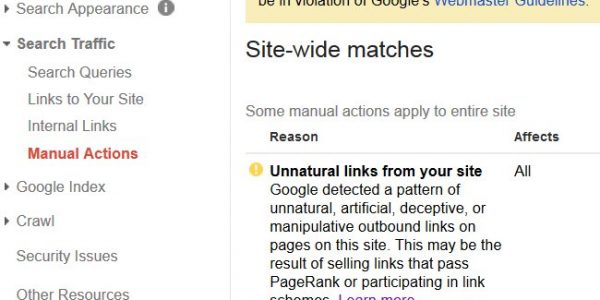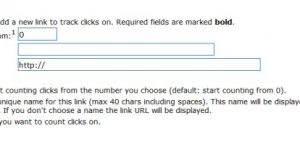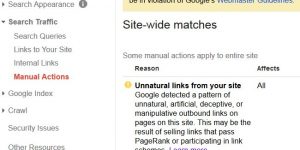Comment on Google Penalty Recovery by SEO Dave.

What I have found is not to waste too much energy/resources on thin affiliate sites as they are generally downgraded within a year, basically do as little link building as possible to make the site profitable, but don’t aim for hard SERPs. I have a lot of sites I can link from, so can setup a test site, add a number of links and wait to see what happens. I’ve been running SEO tests for about 10 years, with affiliate content tests they can take a couple of years to be sure of the results.
When a non-affiliate content site is downgraded it can be a pain to get it ranked again even when you know what the issue was and you’ve removed the problem. No one knows exactly how Google etc… mark a site as not worthy of indexing/full ban (worst case scenario) or ranking well/Google penalty (still bad, but at least the site is indexed).
Based on the time frames of this and the randomness I strongly suspect there’s a manual element to downgrading a site in Google. Although I can’t prove it I have in my mind that Google works this way.
Google tries to automate everything.
If it fully automated all duplicate content filtering it would downgrade a lot of very good sites, so there must be a manual part to the process.
Since thin affiliate sites can get ranked quite well short term (the first year) clearly the downgrading isn’t automated on the content alone: it would be quite easy to downgrade all content not considered the original, though that throws open the question how do they determine original source.
I think the automated part is looking for sites with footprints that suggest they are thin content sites (affiliate site footprints). This can be looking for a site with content that appears to be only duplicate content, looking for sites running scripts (plugins like the Massive Passive Profits plugin) that leave footprints behind like linking to images within the plugins folder structure (like the buy now image) and of course linking to affiliate sites.
Google has employees that check sites to see if they are thin affiliate sites, there was a manual for these employees leaked and it tells them to look for affiliate sites that add no value to the affiliate content (affiliate content was OK, but it had to have added value like comparison shopping sites, review sites, with user reviews).
I believe a list of sites that have been found in the Google index by looking for footprints are given to the Google manual reviewers and they go through them. This takes time and would explain why thin affiliate sites can be ranking OK for months, even ranking for over a year before they are downgraded because they haven’t been checked and downgraded yet.
This is what I suspect is going on, but obviously can’t prove it.
As thin affiliate content users we have to go out of our way to hide those thin affiliate content footprints for as long as possible, so rather than having our average affiliate site downgraded in under 9 months, we extend it to a year plus.
It’s practically impossible to remove the duplicate content footprint, but so many sites these days use duplicate content (copying RSS feeds etc… and not just scraper sites) I suspect this alone won’t get a site flagged as possibly an autoblog (or at least not flagged high on the list to be checked).
Linking to affiliate networks like Amazon, Sharesale etc… we can hide the affiliate links from search engines. In the next version of my theme Amazon links created by the MPP plugin are invisible to Google etc…
Referencing (linking) to images or other files within the folder structure of a scrapper script/plugin. The MPP plugin Amazon Buy Now link is one such image, I’ve solved that problem in the themes next release.
As you can see it’s a battle that Google etc… wins in the long term. that being said it can be worthwhile to generate affiliate sits, but it has to be in bulk as they tend not to make a lot of money for long.
I would advise when creating thin affiliate sites is not to go over the top on backlinking. Add enough links to get the site indexed and move on to another site. It’s not worth spending loads of time link building only for the domain to be downgraded within a year.
Once a site is downgraded I’d look at how profitable it is while in that state, if it’s worth keeping, keep it, if not let it die. I can’t think of anything you could do after a site is running and making money to stop it from being downgraded. I suppose if you had a thin affiliate site that was making a lot of money you could replace the affiliate content with unique content or add some unique content for the front of the site (so it might pass a quick manual review). Imagine you had a site with 10,000 posts and the front 100 was unique and you were lucky that the manual reviewer only checked the 100 unique articles, you might get away with it.
I’m working on the principle the majority of autoblogs will be downgraded in under a year no matter what we do, but if we remove the obvious affiliate footprints it might extend it to over a year (I doubt it will extend to indefinitely though). My tests for this are still active (about 3 months old), so I don’t know yet (I know what happens when you don’t remove the footprints).
David


More Comments by SEO Dave
SEO Penalty
Free SEO Advice by Email
I only provide free support to Stallion Responsive Theme users by email for support related to Stallion Responsive (nothing else, no general SEO advice by email).
The above sounds like a general SEO advice question and so the answer to your …
Continue Reading Google Penalty Checker
SEO Penalty
Monetizing a WordPress Blog While Avoiding a Google Penalty for Selling Links
I’m not familiar with Blogads, though understand what they are offering and considered using a service like them (not got around to it :-)). Have you looked at their ad output (I couldn’t find an actual ad example on their …
Continue Reading Google Penalty Checker
SEO Penalty
How to Check for a Google Penalty on an Autoblog
A downgraded autoblog site is harder to spot than a banned one. A banned in Google autoblog is easy to spot, it’s basically no longer indexed (used to be) despite backlinks.
For a site that’s downgraded (penalized) you’ll tend to see …
Continue Reading Google Penalty Checker
SEO Penalty
Google Reconsideration Request
Hi,
I can’t guarantee all penalties that can be lifted in an automatic fashion (as in you fix all the problems, Google respiders finds a clean site and reincludes the site) are going to be on a 3 month scale. I …
Continue Reading Google Penalty Checker
SEO Penalty
SEO Penalty Recovery Failed!
I don’t believe it, roughly 7 days after the traffic recovered it died again!
The traffic hadn’t fully recovered, suspect because not all pages indexed, but it was heading for around 7,000 visitors a day which is a full Google SEO …
Continue Reading Google Penalty Checker
SEO Penalty
Google Penalty Recovery Process
Thanks for the good luck on the Google penalty recovery.
So far almost 48 hours of pre penalty traffic, not quite fully recovered, but 7,000 visitors a day is much better than 1,200. Over the last few months the number of …
Continue Reading Google Penalty Checker